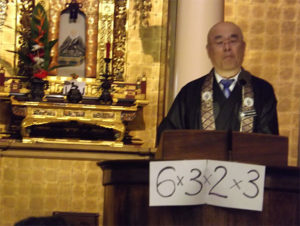Submitted by Betsuin board member David Atcheson.
Hawaii Betsuin celebrated two services for New Year’s 2017: one on New Year’s Eve and one on New Year’s morning.
At the conclusion of the New Year’s Eve service just before midnight, attendees filed out of the main temple hall (hondo), each taking a turn to strike the temple bell (kansho) with a wooden mallet for a total of 108 times.
By striking the kansho, we symbolically “ring out” our passions and delusions and aspire to become free of them in the new year. But why 108? Our chief minister (Rimban), Rev. Toyokazu Hagio, explained in his New Year’s Eve message. His visual aid included some some math:6 x 3 x 2 x 3
The “6” represents our six senses of sight, touch, sound, taste, smell, and consciousness. The “3” indicates the different ways those sensations are experienced: good, bad, or neutral. The “2” is for the dimension of attachment to pleasure: attached or unattached. The final “3” represents past, present, and future. Multiply the numbers together and you get 108.
The New Year’s Eve service also included a message in Japanese by Rev. Yuika Hasebe and a Mettabhavana (loving-kindness meditation) by Rev. Satoshi Tomioka. After the bell ringing, attendees gathered in the Social Hall for soba (buckwheat noodles) and other traditional New Year’s foods.
The following morning’s service included a message in English by Honpa Hongwanji Mission of Hawaii Bishop Eric Matsumoto and a Japanese-language message by Rimban Toyokazu Hagio. Followed again, of course, by more fellowship and traditional New Year’s foods in the Social Hall!
Our next major services are for Ho’onko on Saturday, January 14 (7 p.m.) and Sunday, January 15 (9:30 a.m.). Ho’onko services are observed to express our sincere gratitude to Shinran Shonin, the founder of Shin Buddhism.



